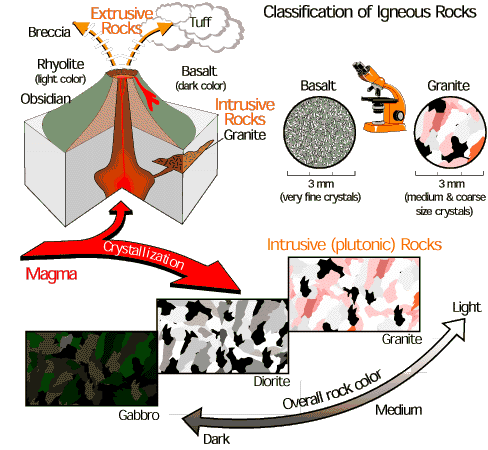Major Rock Groups
1. Igneous
2. Sedimentary
3. Metamorphic
Sub Group of Igneous
4. Vesicular
1. Igneous Rocks
-Igneous rocks form when molten rock (magma) cools and solidifies forming a rock.
-When looking for an igneous rock, look for small crystals.
- Igneous rocks are categorized by
1. Grain Size:
-Intrusive: form slowly under the earth and produce large crystals that are visible to the naked eye. -Some intrusive rocks are granite, diorite, and gabbro.
-Extrusive: form quickly at the earth’s surface, producing very small, microscopic grains.
-Some extrusive rocks are basalt and rhyolite.
2. Mineral Content
-Felsic: light in color
-Mafic: Dark in color

2. Sedimentary Rocks
-Form from compaction and cementing of existing rock fragments formed from plant and animal remains
-Form from.....
1. Weathering: The rock decays and breaks down due to physical & chemical processes. 2. Erosion: The soil and rock gets moved downhill or downwind and eroded.
3. Deposition: Sediment settles in flat, horizontal layers.
4. Transportation: Movement of sediment via water, wind or air.
5. Lithification: The rock compacts and cements together.
-There are 3 types of sedimentary rocks...
1. Clastic/Terrigenous: forms from particles of the above processes.2. Biogenic: contains fossils or shells.
3. Chemical: formed from precipitation of salts from solutions.
-Sedimentary rocks are classified by their grain size...
1. Boulder (largest grain size)2. Cobble
3. Pebble
4. Sand
5. Silt
6. Clay (smallest grain size)
-Sedimentary rocks that are formed closer to rivers will have bigger chunks in them and as you get farther away from the river the particles get smaller. This is because the closer to the river you are the higher the velocity is and the farther away you are from the river the lower the velocity. Close to the river would be large particled rocks such as Conglomerate and farthest from the river would be small particled rocks such as shale.

3. Metamorphic Rocks
-Form when igneous, sedimentary, or other metamorphic rocks change due to heat and or pressure.
-Divisions of metamorphic rocks...
1. Foliated, (banded): divided then into fine, medium or coarse grained.
2. Non-Foliated, (non-banded): divided into "reaction with HCL" or "No reaction with HCL"

4. Vesicular Rocks
-Vesicular rocks are not one of the main 3 catgeories*
-Vesicular rocks are not one of the main 3 catgeories*
-They are also known as "frothy lava"
-They form when hot gasses get caught in lava, which when hardened creates little air bubbles in the rocks.
-Examples...
1. Pumice 2. Scoria
So vesicular are igneous rocks? Can they be classified as extrusive?
ReplyDelete